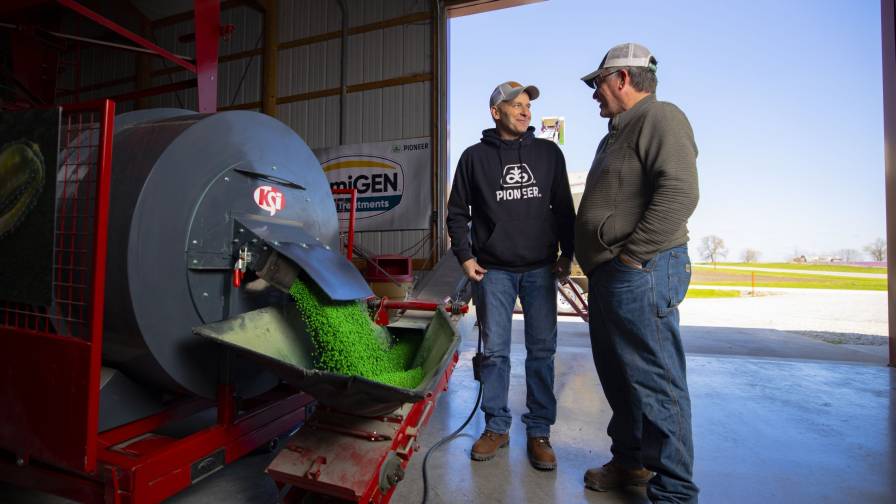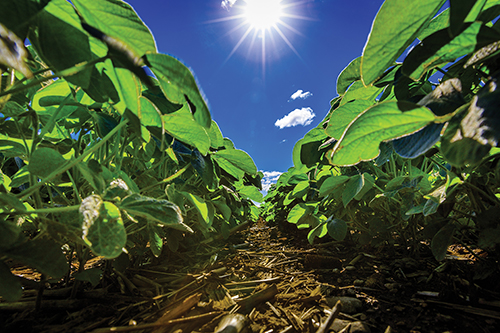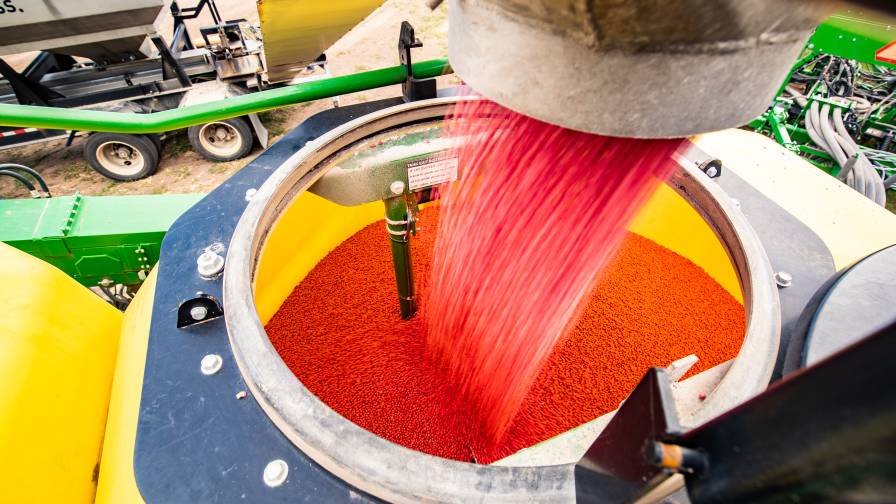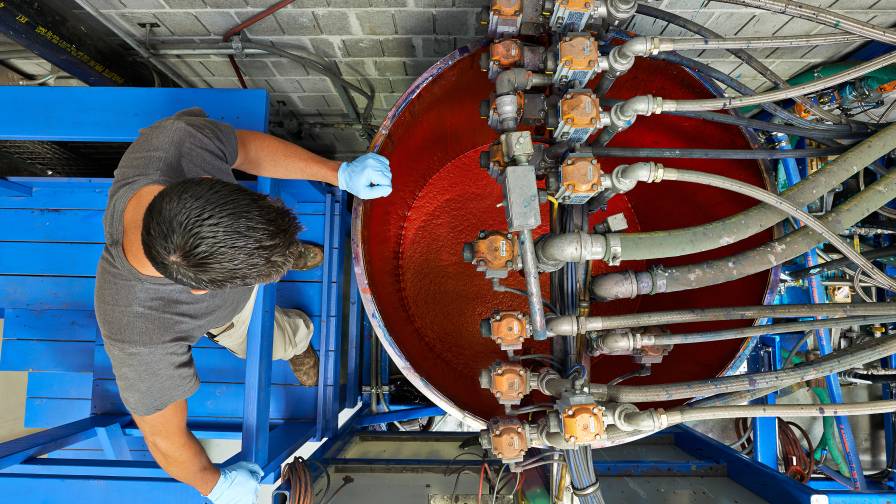Seed Treatment ROI: These Factors Are Influencing Growth of the Seed Care Market

A number of factors are helping the seed treatment market to continue delivering ROI, according to retailers and suppliers alike. Photo: Corteva Agriscience
Before seeds go into the ground, growers ensure their crops receive the treatments they need.
“In 2024, the seed treatment industry is evolving,” says Paul Johnson, Seed Treatment Market Manager at Wilbur-Ellis. “We are continuing to experience growth, but we are also observing a trend where some markets are trading down the value ladder, prioritizing more cost-effective solutions over premium products.”
According to Blake Murnan, Manager of Product Development, CHS, “The seed treatment industry in 2024 was strong for downstream treating in the upper Midwest. Total soybean acres in 2024 were estimated to be 87.1 million acres, which was a 4% increase over the previous year. Soybeans really have two treatment options — pathogen protection with synthetic chemistries and nitrogen-fixation with inoculant treatments. The increased acreage in soybean production drove an increase in both those seed treatment categories last year.”
The market is complex and continues to evolve.
“The seed treatment business continues to be a dynamic area,” says Brad Van Kooten, Seed Applied Technology Leader, Corteva Agriscience.
In addition, seed treatments continue to grow “in spite of substantial channel destocking in 2024, as farmers adopt technology innovations to address critical challenges including Sudden Death Syndrome (SDS) for soybean and the control of plant-parasitic nematodes,” says Quinn Showalter, Head of Seedcare and Biologicals, North America, Syngenta. “We see robust growth and significant opportunities in the U.S.”
Like pesticides that are manufactured to target specific pests, so too have seed treatments.
“With newer chemistries entering the market that are laser-focused on certain pathogens, we’re seeing a trend to utilize these chemistries along with well-tested proven chemistries to develop a well-balanced seed treatment approach to protecting seed from a wide range of pathogens and pests,” says CHS’ Murnan. “It is an exciting time in the seed treatment industry to see these different chemistries work in synchronization with each other.”
Drivers
“Yield is the driving factor for seed treatments,” says Murnan. “Without it, a grower may struggle when commodity prices are low and miss out on opportunities to grow when commodity prices are high.”
Two of the industry’s wide-spread challenges have been Soybean Cyst Nematode (SCN) and SDS.
“In the U.S., the persistent increase in the incidence of SDS in soybeans over the past decade has been a significant driver,” says Syngenta’s Showalter. “We’ve also noticed diseases such as red crown rot become much more prevalent; we heard a lot of concern among farmers in the Midwest as red crown rot is potentially even more devastating than SDS.
“This level of customization of seed treatment solutions, especially in certain crops such as corn and cereals, allows farmers to address seed treatment technology gaps in the seeds they choose, and to better protect their seed investments,” Showalter continues.
Seed treatments do far more than simply solve pest problems.
“One of the biggest trends over the past few years is to value-added products designed to enhance or even replace traditional fungicide and insecticide treatments,” says Wilbur-Ellis’ Johnson. “Growers are increasingly interested in integrated solutions that offer multiple benefits, such as stress mitigation, enhanced nutrient uptake, and improved root development.”
2025 and Beyond
“I see the seed treatment segment continuing to grow — meaning, not just by finding more untreated acres to treat, but also utilizing new and improved products within a seed treatment for acres currently using seed treatments,” CHS’ Murnan says.
Syngenta’s Showalter agrees the seed treatment market looks bright.
“At Syngenta, we have a robust pipeline of new and highly effective technologies as well as an expanding portfolio of biologicals, and we expect our business to grow on the back of new product launches and greater awareness of the threat from plant-parasitic nematodes,” he says. Much of that optimism comes from the new products that are or will soon be available.
“The use of biologicals is certainly an emerging trend, and we continue to see them being added to seed treatments and used in corn overtreatment,” Showalter says. “We also notice start-up companies create application equipment that increasingly enable on-farm treatment of seeds.”
In the next few years, retailers will have a number of products to offer their grower-customers.
“We screen hundreds of products each year,” Corteva’s Van Kooten says. “The bar is very high to make it into the LumiGEN seed treatment portfolio. Many early-stage experimental products don’t make it but this year, we saw several new products that look promising for future evaluation and testing.
“Traditional chemistries continue to bring tremendous value to our customers,” Van Kooten says. “And we continue to find new chemistries that provide value to our seed treatment portfolio.”
Manufacturers expect to see continued market growth next year.
“Looking ahead to 2025 and beyond, we expect the seed treatment segment to continue to evolve,” says Wilbur-Ellis’ Johnson. “We will continue to focus on providing the best agronomic solutions that produce the best ROI for the customer. We will maintain our commitment to innovation by collaborating with our crop nutrition and biological teams to develop integrated seed treatment offerings that provide enhanced protection, nutrient availability and improved crop resilience.
Challenges
“Innovation costs and proper outreach all the way down to the grower to show, educate, and indeed, prove the value of innovations in the seed treatment sector,” says CHS’s Murnan.
Syngenta’s Showalter offers another speedbump.
“The largest challenge impacting the seed treatment industry is the urgent need for effective regulatory frameworks around the world that support the efficient introduction of innovative crop protection technologies and seed treatments,” he says. “We also are committed to continuing to raise grower awareness of pests that are not as visible — such as plant-parasitic nematodes in soil — or evolving pest and disease threats such as Fusarium stalk rot in corn and Fusarium crown rot in wheat.”
“In the U.S., the length of time required to register new crop protection active ingredients has substantially increased following new policies under the Endangered Species Act — in some cases this has doubled,” Syngenta’s Showalter says. “
This is already impacting the ability of U.S. growers to access cutting-edge technologies and innovations and is frustrating particularly for U.S. growers who now see farmers in other markets able to use new technologies — including biologicals — more quickly,” he continues. “We also see still quite a lot of ambiguity in terms of what manufacturers can expect and plan for in terms of the speed of the regulatory approval process. All of this is starting to add significant time and obviously the impact of that is putting a huge drag on getting technology to U.S. growers.”
Opportunities
“The biggest opportunities for seed treatments are the biggest threats to a healthy crop,” says CHS’ Murnane. “For example, soybean cyst nematode is the No. 1 pathogen in soybean production. As an industry we have not done a lot to combat this threat both from an education and input standpoint. Our biggest challenge is to get everybody on board on the value of seed treatments through education.”
While the same pests seem to be similar year after year, the solutions designed to tackle that change.
“The biggest opportunity for seed treatment is the ability to bring to market new technologies,” says Syngenta’s Showalter. “Our TYMIRIUM technology and PLINAZOLIN technology are set to be game changers in protecting seeds from nematode, disease and insect pressure, and boosting crops’ production potential. Biological products such as nutrient use efficiency products and biostimulants are just starting to be recognized as contributors to crop yield, and so we are confident to bring more awareness on the science behind these products to the market and a good investment for the growers.”








